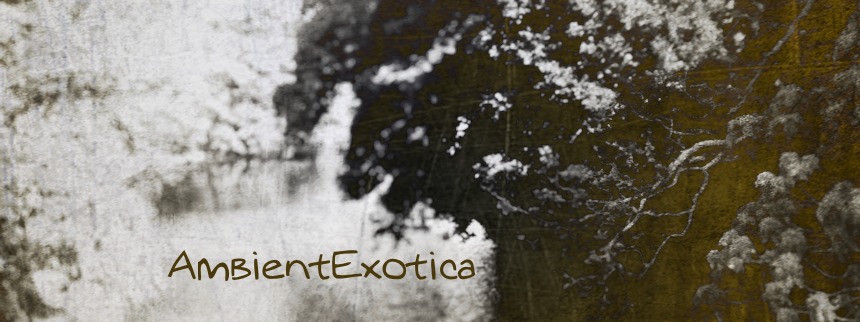
Eric Fourman
Transparent
2013
A look at the front artwork of Nashville-based Eric Fourman’s self-released five-track album Transparent and another glimpse at its title, and the expectation is set in the listener’s head: this is a hibernal album of winter memories. It is exactly here where one might play the infamous “sad trombone” sound file, for this is decidedly not what the album is about. Forget about all earthen things, as the artist takes the listener to the vast emptiness of space. Been there, done that? Sure, Space Ambient albums have their ever-growing fan base. Phillip Wilkerson, Gel-Sol, even classically trained clarinetist Tony Scott and of course the notorious György Ligeti have all visited the genre, some of them briefly, others regularly. In this regard, Eric Fourman is an irregular visitor of the genre as of yet, Transparent is his first galactic work, available at Bandcamp for free. Mostly improvised and more felt than played, I am not so sure about the artist’s statement regarding the improvisational part. He might be a skilled pianist or just talented, for there is one particularity that elevates this seemingly picayune artifact and allows Fourman to firmly face the friendly competition: comparably complex tone sequences. While Transparent remains a dedicated Drone work supercharged with wadded synth molecules, dark matter stripes and other cosmic cornucopias, there are multitudinous glistening chimes, vesicles and other flecks encapsulated in the arrangements. It thus deserves an in-depth review, methinks, where I am going to carve out the luring aspects and the more clichéd patterns.
Quasar launches the album in that specifically beautiful way, for even though every sound has already been delivered in the wide realms of Ambient music, there is that certain retrogressive texture that sucks me in, time and again: good old-fashioned square lead pads. Here, Eric Fourman creates their heavily reverberated afterglow with a calcined glissando and heterodyned tone sequences which emanate a rubicund forsakenness, an incredible melancholy. This fragile luminosity is not placed in a pith of nonentity, but gyrates majestically around a galactic airflow of synth washes. Spacey and eminently catchy, the duo of patterns is further ennobled by clichéd but somewhat mandatory laser sounds and alkaline dark matter vestibules which change into semi-dissonant space organs later on. Quasar is a quiet piece which still benefits from higher volume levels due to said square lead protrusions and the revved up cacophonous cinematography in the second phase. Follow-up Neutrino is an asbestus-fueled noise heliosphere of over seven minutes where the pads of the main aorta are shimmering in dazzling colors, distantly resemblant of pentatonic tone sequences, but even if these were glaringly audible, they would be crushed to pieces due to the aggressive – or rather firm – attitude of the melody. It shuttles between self-pitying bile and coruscating credence, the latter of which is undoubtedly ameliorated by the alloy of vitreous galactosamines. These molecules illumine the scenery and soften its aggression… oddly enough via sparkling clarity.
Reverse Continuum is next and is a hit-or-miss affair; due to its enormously stereotypical physiognomy, it depends more than ever on the listener what to make of its characteristic traits. Firstly, the listener is greeted by a complexion of histrionic dark pads whose murkiness is brazen and cheesily danger-evoking. But Eric Fourman soon pushes the track into a different direction, as these darkest of all runlets becomes entangled with – genuinely gorgeous – prolonged gongs whose abyssal depth echoes through the tense immediacy of this maelstrom. This layering technique, to my mind, successfully camouflages the directionless tones which are placed in an alatoric fashion. Still, Reverse Continuum is no bad track, especially not if one is keen on blurrier, less spiky or piercing synth intertwinements, for the latter part is designedly diffuse and blurred, potentially cozy but still tense due to the cautiously erected cacophony complete with screeching synth strings. Afterwards, and only a few seconds shy of the ten minute mark, Blackhole starts in a surprisingly less melodramatic fashion even though its title is predestined to create exactly this very atmosphere. Strangely enough, but successfully so, Fourman decides to present a silkened nod to the opener Quasar, at least surface-wise, by displaying a mellowly muffled mélange of square lead pads. These are drowned in bass nebulae whose only protuberances consist of whirling flashes and Korg-oid vibrato helixes. It is these helixes that grow and unite, somehow invoking a warm feeling. The end is nigh though, as the titular whorl is reached via heftily metallic static noise fluxions and bit-crushed electric guitars. Simultaneously, soft fogs twirl in close proximity.
The finale and centerpiece then is called Oblivion, a long-form polymorphous piece of almost 20 minutes. It is here where all the previous ingredients are reunited, but not in a kind of vernissage, but grafted upon each other anew, with previously unheard segues, different moods and varying radiance. Oblivion opens with an elastically bouncing ice gale whose hazardous coldness orbits around a wondrous concoction of synth streams which evolve, transmute gracefully and evoke a solemn yearning. Fourman finally injects a truthful euphony in the tones, at least occasionally so, letting the anacrusis shine brightly. Together with the more dun counterparts, this creates – and augments – the ultimate feeling of melancholia. The main body then adds the expected square lead pads whose tumbling echoes and high frequency ranges resemble joyous polar lights. A humane warmth wafts through the aural air, completely ignoring the pernicious portent of the title. Since Oblivion can only grow as it must lead to the final conclusion and live up to its title, like-minded gigantic synth bands and volitions are stacked upon each other and float through the whitewashed interstices. The final stage of Oblivion is no tohubohu or turmoil, not even a bellicose mayhem, but surprises with its synthetic alto flute tones or electric piano particles which then accompany the dying stages of a synth choir and are the last thing one hears before the album closes for good.
Eric Fourman’s galactic ambience is a place – or rather several places – I would well like to live in, if that makes any sense at all. The artist may not have planned a superimposition with this album, but as all good Space Ambient albums tend to unveil, there is a poignant sense of wideness and megalomania embroidered in the starlit sceneries, making the natural, way too earthbound front artwork all the more de trop. The synth spirals and solar winds are delicately texturized, and once you know a cosmic Ambient album, you already know what to expect way before the first tone hits. Regardless of met expectations, there are three particular things Eric Fourman does right: firstly, the shimmering aura of the square lead pads enchants me endlessly, and I am all the more glad that these elements appear transparently in three out of five tracks. Since this is one of my personal favorite retro textures which are not necessarily compatible to all Ambient fans, other listeners might beg to differ, but I for one am definitely hooked by them. Secondly, the artist uses an old trick that is found throughout the boundaries of ethereal Ambient music, but which works very well here, and that is the use of cacophony. Indeed, once several incongruent layers are laid onto themselves, their impetus and force grows exponentially, displaying the orderly chaos that rules the universe as we currently know it… or don’t know. Thirdly, the unchained melodies are among the more prolific ones in that genre. One cannot possibly hum along to them, true, but the many arabesques, martelato phases and ornamental intersections make the melodies rule over the endemic universe, i.e. the very location created and made possible by the various notes. Transparent is a surprisingly convincing work considering its humble scope, and it will therefore find a constant place in my Space Ambient playlist.
Further listening:
You can download the album for free at Bandcamp.
Ambient Review 314: Eric Fourman – Transparent (2013). Originally published on Feb. 12, 2014 at AmbientExotica.com.
